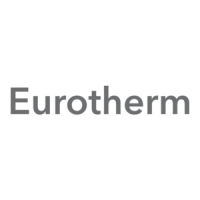
Do you have a question about the Eurotherm 32h8i and is the answer not in the manual?
| Brand | Eurotherm |
|---|---|
| Model | 32h8i |
| Category | Security System |
| Language | English |
Details the items included in the indicator packaging for setup.
Shows front view dimensions for different models.
Illustrates side and top dimensions for various models.
Describes the process of mounting the indicator onto a panel.
Provides panel cut-out dimensions for different indicator models.
Specifies minimum spacing requirements between indicators.
Explains how to safely remove and reinsert the indicator from its sleeve.
Details terminal connections for the 32h8i indicator model.
Details terminal connections for the 3216i indicator model.
Details terminal connections for the 3204i indicator models.
Specifies acceptable wire sizes for terminal connections.
Provides guidance on connecting various sensor inputs.
Details configuration of relay and retransmission outputs.
Explains the function and availability of digital inputs.
Details the 10Vdc transducer supply for specific models.
Covers power supply requirements and external fusing.
Illustrates a typical wiring setup for a strain gauge connection.
Explains Modbus communication options (EIA232/EIA485).
Details specific input/output configurations for the 3216i model.
Covers safety symbols, personnel, enclosure, wiring, and power isolation.
Covers voltage limits, pollution, grounding, over-temperature, EMC, and wire routing.
Guides through initial configuration using Quick Codes.
Describes the startup sequence for pre-configured units.
Explains the indicator's front panel components and their functions.
Describes how alarms are indicated via display and beacon.
Explains how the display indicates out-of-range input values.
Details how sensor break conditions are indicated.
Introduces parameters accessible for daily operation.
Explains how to use the tare function for weighing applications.
Guides on accessing Operator Level 2 using a passcode.
Lists and describes parameters available in Level 2.
Continues listing and describing Level 2 parameters.
Details the procedure for calibrating a load cell directly.
Explains calibrating against a second reference device.
Describes shunt calibration for strain gauge transducers.
Outlines the manual calibration steps for zero and span.
Details the process for automatic strain gauge calibration.
Explains calibration via an external digital input.
Guides on saving current settings into one of five recipes.
Explains how to recall stored recipe settings.
Details specific features for FM and Alarm units.
Describes Level 3 access for all operating and alterable parameters.
Explains Configuration Level for fundamental instrument changes.
Provides step-by-step instructions for selecting Level 3 or Configuration.
Explains how to navigate and select parameter list headers.
Guides on selecting specific parameters within a list.
Details the format of parameter display and scrolling banner.
Explains how to modify parameter values using the keys.
Describes how to return to the main display from parameter lists.
Explains the timeout behavior for certain parameters.
Lists and describes parameters for configuring process inputs.
Continues listing input parameters like Type, Units, and Filter.
Details available input types and their corresponding ranges.
Continues listing input types and their ranges.
Details configuration of Output 1 for specific models.
Explains how to scale the DC output for desired readings.
Lists and describes parameters for digital input configuration.
Lists and describes the six available alarm types.
Details how alarms operate relay outputs.
Explains how alarms are visually indicated on the display and beacon.
Guides on acknowledging active alarms.
Describes how pre-alarms are activated relative to alarm setpoints.
Illustrates alarm behavior with non-latching configuration.
Illustrates alarm behavior with manual latching.
Illustrates alarm behavior with auto latching.
Guides on saving current settings into one of five recipes.
Demonstrates saving modified settings into a recipe.
Explains how to recall stored recipe settings.
Details wiring for EIA232 and EIA485 communication interfaces.
Explains simple master communication for sending single values.
Details master configuration for sending values to slaves.
Shows wiring diagrams for EIA232 and EIA485 master/slave connections.
Explains how to verify input calibration accuracy.
Lists important precautions before calibration.
Details checking mV input calibration with a source.
Explains checking thermocouple calibration and CJC.
Guides on checking RTD calibration using a decade box.
Details the procedure for a five-point offset calibration.
Details calibrating the mV range, including mA inputs.
Explains calibrating thermocouple ranges and CJC.
Details calibrating mA outputs using an ammeter.
Explains how to restore factory calibration settings.
Refers to section 5.3 for transducer calibration procedures.
Explains how to load Instrument Definition Modules (IDMs).
Details methods for connecting a PC to the indicator.
Details configuring the input type, units, and range via the wizard.
Guides on setting alarm types, thresholds, and hysteresis.
Explains how to configure output relay behavior based on alarms.
Guides on defining which parameters are included in a recipe.
Explains how to set values for parameters within a recipe.
Describes how to assign names to stored recipes.
Guides on configuring input parameters via the browser view.
Details configuring alarms using the browser view.
Demonstrates setting and storing alarm thresholds in recipes.
Guides on saving instrument configuration to a clone file.
Explains transferring configuration to a new instrument.